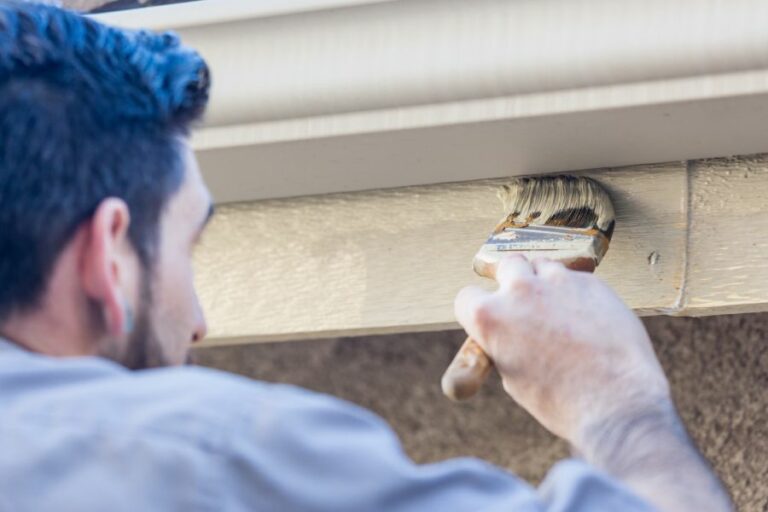Utilizing Paint Removers And Strippers For Surface Preparation
Have you ever struggled with removing old paint or stubborn stains from various surfaces? Look no further, as we are here to provide you with the best methods to get the job done efficiently and safely. Utilizing paint removers and strippers is an essential step in surface preparation, ensuring a clean and even canvas for any refinishing project.
Utilizing paint removers and strippers for surface preparation:
Utilizing paint removers and strippers is essential for surface preparation in painting projects. They help remove existing paint or coatings, ensuring a clean surface for new paint application. Available in forms like liquid, gel, and paste, these removers come in solvent-based, bio-based, and caustic-based types, each suited for specific surfaces and project requirements. Proper application and removal techniques are crucial for successful surface preparation.

Discover the secrets to flawless surface preparation using paint removers and strippers. Learn about different types, application techniques, safety tips, and more! Keep reading and become an expert in no time.
Contents
- 1 Effective Paint Removers and Strippers for Surface Prep
- 2 Exploring Surface Cleaning and Paint Elimination Techniques
- 3 Top Three Techniques for Paint Stripping Uncovered
- 4 Understanding the Key Functions of Paint Removers
- 5 Common Methods for Paint Removal: A Comprehensive Guide
Effective Paint Removers and Strippers for Surface Prep
Project preparation is an essential aspect of any painting job, particularly when it comes to surface restoration. Inadequate preparation can result in poor paint adhesion and reduced durability, leading to unsatisfactory results in the long run.
Using paint removers and strippers is a vital step in the surface preparation process, ensuring that the surface is properly cleaned, free from existing paint or coatings, and ready for new paint application.
• Types of Paint Removers and Strippers
Paint removers and strippers are available in various forms, including liquid, gel, and paste. They are designed to break down and remove a wide range of coatings, such as paint, varnish, lacquer, and sealers.
The choice of paint remover or stripper mainly depends on the project’s requirements and the type of surface.
– Solvent-Based Paint Removers
Solvent-based paint removers contain chemicals that typically dissolve the bond between the paint and the surface. These strong chemicals can be effective in removing multiple layers of paint in a short period. Common types of solvent-based paint removers include:
- Methylene chloride-based removers
- N-Methyl-2-pyrrolidone (NMP) based removers
- Acetone, toluene, and methanol mixtures
Caution: When using solvent-based removers, always work in a well-ventilated area, wear protective gear, and follow safety instructions on the label, as these chemicals are hazardous.
– Bio-Based Paint Removers
Also known as “green” paint removers, bio-based paint removers contain biodegradable ingredients derived from plants, such as soy and corn. They are less hazardous than solvent-based alternatives and produce fewer harmful fumes.
However, they tend to take longer to remove the paint and may need multiple applications.
– Caustic-Based Paint Removers
Caustic-based removers use strong alkalis, like sodium hydroxide or potassium hydroxide, to break down the paint on a surface. While they are effective in removing paint, they can corrode certain metals and weaken wood fibers, requiring a neutralizing agent after use.
• Surface Preparation Using Paint Removers
To achieve the best results, follow these steps when using paint removers and strippers for surface preparation:
1. Test the Compatibility
Before applying the paint remover on a large area, test it on a small, inconspicuous portion of the surface to ensure compatibility and determine the required dwell time. Different coatings and surfaces may react differently to the remover.
2. Apply the Paint Remover
Using a brush or roller, apply a thick layer of the paint remover to the surface, following the manufacturer’s instructions for coverage and dwell time. For optimal results, consider applying the remover in sections for large surface areas.
3. Allow the Remover to Work
Allow the paint remover to dwell on the surface for the recommended time or until the paint starts to bubble or lift. This may take anywhere from 15 minutes to several hours, depending on the type of remover and the coating being removed.
4. Remove the Paint
Once the paint has softened, use a scraper or putty knife to gently lift and remove the paint. For difficult-to-reach areas, use a brush or abrasive pad. Take care not to damage the surface.
5. Clean the Surface
Thoroughly clean the surface with mineral spirits, water, or a suitable cleaner, depending on the type of remover used and the surface material. Make sure to remove any residue of the paint remover and paint particles. For porous surfaces, such as wood or concrete, use a brush or power washer.
6. Neutralize and Rinse (Caustic-Based Removers)
If you have used a caustic-based remover, apply a neutralizing agent to the surface according to the manufacturer’s instructions. Rinse the surface thoroughly and allow it to dry completely before applying any new coatings.
7. Inspect and Repeat If Necessary
Inspect the surface for any remaining paint, and repeat the removal process if necessary. For stubborn spots or multiple layers of paint, it may take several applications of the remover to complete the process.
• Tips on Choosing the Best Paint Remover
When selecting a paint remover, consider the following factors:
- Type of coating: Different removers have varying chemical compositions and are suited for specific types of coatings. For example, methylene chloride-based removers work well on epoxy and polyurethane coatings, whereas NMP-based ones are effective on latex paints.
- Surface material: Some paint removers may cause damage or discoloration to certain surfaces. Always test the remover first to ensure compatibility.
- Duration of the project: Solvent-based removers work faster, while bio-based ones are slower-acting but less toxic. Choose a remover based on the project timeline and safety requirements.
- Environmental impact: Consider using environmentally friendly bio-based removers for projects that require minimal chemical exposure and generate less waste.
Successful surface preparation is crucial for achieving professional, long-lasting results in any painting project. By using the right paint removers and strippers and understanding the proper techniques for application and removal, you can ensure a clean, well-prepared surface for a fresh coat of paint.
Exploring Surface Cleaning and Paint Elimination Techniques
• Introduction
Surface cleaning and paint removal are essential processes in various industries, such as construction, automotive, and manufacturing. The primary purpose of these processes is to remove contaminants, dirt, and old paint from surfaces in preparation for new paint application or other finishes.
• Why Surface Cleaning and Paint Removal Matters
– Protecting Surfaces and Improving Adhesion
Surface cleaning and paint removal are critical steps in maintaining the integrity and appearance of various materials. The removal of contaminants, dirt, and old paint ensures that the surface is clean and smooth, resulting in better adhesion of new paint or other coatings. Proper surface preparation helps to prevent problems such as paint peeling, chipping, and blistering.
– Enhancing Aesthetic Appeal
A well-executed paint job can significantly improve the appearance and aesthetics of structures, vehicles, and products. A clean and uniform surface allows for the even application of paint and enhances its overall aesthetic appeal.
– Reducing Maintenance and Repair Costs
Proper surface cleaning and paint removal can also lower long-term maintenance and repair costs. Ensuring a clean and well-prepared surface helps in preventing premature paint failure, reducing the need for frequent repainting and touch-ups.
• Methods of Surface Cleaning and Paint Removal
– Mechanical Methods
Sanding
Sanding is one of the most common mechanical methods of surface cleaning and paint removal. The process involves the use of abrasive materials, such as sandpaper, to remove old paint and smooth out the surface.
Sanding is generally appropriate for small-scale paint removal projects, such as furniture refinishing or automotive repairs. For large-scale projects, electric or pneumatic sanders can be used to speed up the process.
Scraping
Scraping is another mechanical method that can be employed for paint removal. Using a scraper, old paint is removed from the surface using manual pressure. This method is generally more labor-intensive than sanding and is most suitable for removing loose or peeling paint.
Abrasive Blasting
Abrasive blasting is a more aggressive mechanical method that involves the use of high-pressure air to propel abrasive materials, such as sand or steel grit, to the surface. This process effectively removes old paint and contaminants, leaving a clean and smooth surface.
However, abrasive blasting can, in some cases, damage the underlying surface and should be used with caution.
– Chemical Methods
Paint Strippers
Paint strippers are chemical solutions that can be used to dissolve old paint and remove it from the surface. The chemicals used in paint strippers can vary, but common ingredients include solvents, acids, and alkalis.
When using paint strippers, it’s essential to follow the manufacturer’s instructions carefully, including wearing appropriate personal protective equipment (PPE) and ensuring proper ventilation.
Caustic Soda
Caustic soda or sodium hydroxide is an alkaline-based chemical compound that can be used to remove paint, especially from metals. The process typically involves dissolving the caustic soda in water and applying it to the surface.
The paint will then soften and can be easily scraped off. It is important to note that caustic soda can be hazardous to both the surface being treated and the person using it, so proper precautions must be taken.
– Thermal Methods
Heat Guns
Heat guns emit a concentrated stream of hot air that can be used to soften old paint, allowing for easy removal with a scraper. This method is most effective on surfaces that can withstand high temperatures without damage.
It’s essential to work in a well-ventilated area when using a heat gun and follow recommended safety guidelines.
Infrared Paint Removers
Infrared paint removers utilize infrared heat technology to loosen the bond between the paint and the surface.
This method is more controlled and does not produce open flames, making it a safer option compared to heat guns. Infrared paint removers are suitable for both interior and exterior paint removal projects.
• Best Practices and Tips
– Start with a Test Patch
Before beginning any paint removal or surface cleaning project, it’s always a good idea to test a small, inconspicuous area to ensure that the chosen method will not damage the underlying surface.
– Choose the Right Tool for the Job
The efficiency and effectiveness of surface cleaning and paint removal methods depend largely on selecting the right tool for the specific task at hand. Consider factors such as the type of surface, the size of the project, and the desired outcome when making this decision.
– Prioritize Safety
Surface cleaning and paint removal can involve potentially hazardous materials and processes. Always wear appropriate PPE, such as goggles, gloves, and respirators, and work in a well-ventilated area.
Furthermore, be sure to follow the manufacturer’s instructions for any tools, materials, or chemicals involved in the process.
• Final Thoughts
Surface cleaning and paint removal are essential processes in maintaining and improving the appearance of various surfaces. By understanding the different methods available and the best practices associated with each, you can achieve professional results while ensuring the safety and longevity of your surfaces.
Top Three Techniques for Paint Stripping Uncovered
As an experienced professional in the field of paint removal, I have often encountered various circumstances that require stripping paint from different surfaces. Based on my expertise, there are three main techniques that are universally applicable and effective for most paint-stripping situations.
• Chemical Paint Strippers
Chemical paint strippers, also known as paint removers, are commonly used to dissolve paint for easy removal. They are available in various forms, including liquids, gels, and aerosols.
Each type has its own set of advantages and disadvantages, but all are designed to break down the bond between the paint and the surface, enabling the paint to be wiped, scraped, or washed away.
– Recommendation
Based on my experience, I recommend using chemical paint strippers when working with stubborn or multiple layers of paint, mainly on wood or metal surfaces.
For best results, I suggest using a paintbrush to apply the stripper and allowing it to sit for the recommended time stated on the product label before removing the loosened paint.
Always remember to work in a well-ventilated area and wear appropriate gloves and eye protection when using chemical paint strippers. Dispose of the paint debris in compliance with local regulations.
• Mechanical Paint Stripping
Mechanical paint stripping involves the physical removal of paint using tools such as sandpaper, scrapers, or wire brushes. This method requires manual labor and is suitable when dealing with small areas or when chemical strippers aren’t practical.
– Recommendation
I recommend using a scraper to remove any loose paint first. Then, use sandpaper or a wire brush to remove any remaining paint layers. To avoid damaging the surface, start with a coarse grit sandpaper and work your way up to finer grits until the surface is smooth and free of paint.
When using mechanical stripping methods, be sure to wear proper eye protection and a dust mask to avoid inhaling the paint particles.
• Heat Paint Stripping
Heat paint stripping is an effective technique that utilizes heat guns, infrared heaters, or steam strippers to soften the paint, making it easier to remove with a scraper or similar tool.
– Recommendation
For heat paint stripping, I find that using a heat gun is the most versatile and practical option for most projects. To achieve the best results, hold the heat gun about two inches away from the surface and move it in a slow, controlled manner to soften the paint without burning it.
Once the paint has softened, carefully scrape it away with a paint scraper.
Remember to wear heat-resistant gloves and keep a fire extinguisher nearby when working with heat stripping methods, as there is a risk of combustion if left unattended. Additionally, heat paint stripping is not well-suited for lead-based paints, as the high heat can release toxic vapors.
In conclusion, chemical, mechanical, and heat paint stripping methods each offers their own advantages for tackling a variety of paint removal situations. Keep in mind the appropriate method will depend on the type of paint, the material of the surface, and the scope of the project.
By understanding the basic techniques and following my recommendations, you can efficiently strip paint and achieve professional-grade results in your own projects.
Understanding the Key Functions of Paint Removers
• Understanding Paint Remover
Paint remover, also known as paint stripper or paint solvent, is a chemical substance designed to strip paint, varnish, or similar coatings from various surfaces, such as walls, furniture, and other objects. This compound makes the task of removing old and unwanted paint easier, faster, and more efficient.
There are many types of paint removers, but they are generally divided into two primary categories: solvent-based and caustic-based.
Solvent-based paint removers contain various chemicals that dissolve paint, while caustic-based paint removers contain chemicals that break down the paint and turn it into a soluble substance.
A third category of paint removers, known as bio-based or green paint removers, has been introduced in recent years. These products claim to be more environmentally friendly and less harsh on the user and the environment.
• Preparing Surfaces for New Paint or Restoration
One primary purpose of using paint remover is to prepare a surface for new paint or restoration. When a surface has multiple layers or an undesirable paint or varnish, a paint remover can effectively break down this coating and expose the original surface. This clean surface is essential for improved adhesion of new paint or a more successful restoration of the original material.
Moreover, using paint remover can help reveal hidden details and intricate designs present on the surface, especially on carved woodwork or molded plaster. This process helps in preserving the original aesthetic value of the piece while making it appear new and fresh.
• Removing Unwanted Graffiti
Paint remover can also serve as a tool to eliminate unwanted graffiti from walls, fences, and other surfaces without causing harm to the original material. Spray paint, which is commonly used for graffiti, can be tough to remove with traditional methods, such as scrubbing or sanding.
In such cases, using a paint remover can prove beneficial in effectively breaking down and lifting off the spray paint from the affected surface. This process allows for a more thorough and less labor-intensive removal.
As graffiti is often created using various types of paints and colors, choosing a paint remover that is effective on multiple kinds of paints and surfaces is crucial to obtain the best results.
• Maintaining Historical Artifacts and Buildings
Historical artifacts and buildings hold immense artistic, social, and cultural value. As time passes, these structures may lose their original appearance due to multiple coats of paint, varnish, or grime.
Carefully using paint removers on these delicate surfaces can help maintain and restore the original appearance of historical artifacts and buildings.
Conserving historical structures often requires the use of gentle paint removal techniques and specialized products designed for delicate surfaces. In these cases, the chosen paint remover should be tested in a small, inconspicuous area before proceeding.
• Safety Precautions and Proper Disposal
When using any chemical substances, including paint removers, it is essential to follow proper safety precautions. Most paint removers contain hazardous ingredients that can be harmful to the user’s health and the environment.
Remember to wear appropriate personal protective equipment (PPE), such as gloves, goggles, and respiratory protection, and work in well-ventilated spaces to minimize the risk of exposure.
Moreover, proper disposal of paint waste and leftover paint remover is crucial to preventing environmental contamination.
Many local governments and waste disposal facilities offer specific guidelines for disposing of hazardous waste. It is essential to follow these regulations to ensure a safer and greener future.
As part of a responsible approach to paint removal and waste management, consult the US Environmental Protection Agency (EPA) for guidelines and recommendations on choosing eco-friendly paint removers and safe disposal practices.
• Final Thoughts and Recommendations
In conclusion, the purpose of paint remover is to provide an efficient and effective method of removing paint, varnish, and other coatings from various surfaces. It is crucial in preparing surfaces for new paint applications, graffiti removal, and preserving historical artifacts and buildings.
When selecting a paint remover, consider the type of paint and surface you will be working on, as well as the environmental and health-related concerns. Lastly, always adhere to the proper safety procedures and standards for responsible paint removal and waste disposal.
No matter the purpose or type of paint remover you may be using, remember that careful consideration and research will provide the best possible outcome for your paint removal project.
Common Methods for Paint Removal: A Comprehensive Guide
• Introduction
Paint removal or stripping is a crucial step in many home improvement and restoration projects. Whether you are repainting a room, restoring antique furniture, or refinishing a wooden surface, it is essential to remove the old paint to create a clean, smooth surface for new paint or finish.
• Chemical Paint Strippers
– What Are They?
Chemical paint strippers are a popular choice for paint removal because they break down the paint’s structure, making it easier to remove. These strippers rely on various active ingredients to dissolve paint, such as methylene chloride, N-Methyl-2-pyrrolidone (NMP), and caustic soda.
– Advantages
- Efficient: Chemical paint strippers can effectively remove multiple layers of paint in a single pass.
- Variety: They come in different forms (gel, liquid, or aerosol), making it easier to choose the right one for your specific project.
- Effective on intricate surfaces: Their ability to penetrate and dissolve paint makes them particularly effective on detailed, carved, or molded surfaces.
– Disadvantages
- Health and safety concerns: Some chemical paint strippers are toxic, and improper use can cause skin irritation, respiratory issues, or other health concerns. Always follow the manufacturer’s instructions and wear appropriate protective gear.
- Environmental impact: Some strippers contain chemicals that are harmful to the environment, so it is crucial to follow proper disposal procedures.
– Recommendations
- For indoor projects or where ventilation is limited, choose a paint stripper with less toxic ingredients, such as soy-based or water-based strippers.
- When working with chemical paint strippers, wear gloves, goggles, and a respirator to minimize exposure to the chemicals.
- To avoid damaging the underlying material, make sure to test the stripper on a small, inconspicuous area before applying it to the rest of the surface.
• Mechanical Methods
– What Are They?
Mechanical methods involve using tools or abrasive materials to physically remove paint from the surface. Common mechanical methods include sanding, scraping, and using a heat gun.
– Advantages
- No chemicals: Mechanical methods do not involve the use of potentially harmful chemicals, making them a more environmentally friendly option.
- Unlimited use: Unlike chemical paint strippers, which may require multiple applications, tools like sanders and scrapers can be used repeatedly without running out.
– Disadvantages
- Time-consuming: Mechanical methods often require more time and effort, especially when dealing with multiple layers of paint or irregular surfaces.
- Surface damage: Inexperienced or aggressive use of mechanical methods can cause damage to the underlying surface, such as scratches or gouges in the wood.
- Dust and debris: Sanding and scraping produce dust and debris, which may require additional clean-up and can pose a health hazard if not properly contained and disposed of.
– Recommendations
- For large surfaces or projects with multiple layers of paint, consider using a power sander or an infrared paint remover to speed up the process.
- If using a heat gun, ensure that the temperature is not too high to avoid scorching the surface or releasing harmful fumes from the paint.
- When sanding, choose the appropriate grit size for your project. Start with a coarser grit and gradually move to finer grit sandpaper for a smooth finish.
- Always wear protective gear, such as gloves, goggles, and a dust mask, when using mechanical methods to protect yourself from dust and debris.
• Conclusion
Both chemical paint strippers and mechanical methods have their advantages and disadvantages, making it essential to choose the right method based on your project’s specific requirements and your personal preferences.
While chemical paint strippers offer efficient and effective paint removal, they do come with safety and environmental concerns.
On the other hand, mechanical methods are more environmentally friendly but can be labor-intensive and potentially damaging to the surface.
By evaluating the pros and cons of each method and following recommended safety practices, you can effectively and safely remove paint from various surfaces to pave the way for a fresh, new finish.
Method | Description |
|---|---|
Chemical Stripping | This method involves the use of chemical paint strippers to dissolve the paint, making it easier to remove with a scraper or other tools. Chemical strippers can be in gel, liquid, or aerosol form. |
Sanding / Abrasive Techniques | This method involves using sandpaper or other abrasive materials to remove paint by wearing it away. Sanding can be done manually or with the use of power tools like orbital sanders or belt sanders. |







